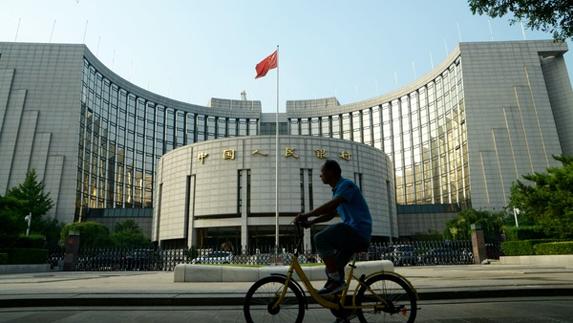 In this undated photo, a cyclist pedals past the headquarters of the People's Bank of China in Beijing. (FAN SHAOGUANG / CHINA DAILY)
In this undated photo, a cyclist pedals past the headquarters of the People's Bank of China in Beijing. (FAN SHAOGUANG / CHINA DAILY)
BEIJING - While the COVID-19 epidemic is taking a toll on the real economy, China's financial authority has managed to bail small businesses out and help them fare better with targeted policy instruments.
The People's Bank of China (PBOC), China's central bank, devised two credit instruments in early June: the loan extension support tool which aims to encourage banks to defer businesses' inclusive loan repayments and the credit loan support tool which is designed to step up loan issuance
The People's Bank of China (PBOC), China's central bank, devised two credit instruments in early June: the loan extension support tool which aims to encourage banks to defer businesses' inclusive loan repayments and the credit loan support tool which is designed to step up loan issuance.
ALSO READ: PBOC plans more rate reforms to cut borrowing costs
As an indication that the effects of the two instruments have become visible, outstanding inclusive loans for small and micro businesses went up by 27.5 percent year on year at the end of July, said Gao Fei, an official with the PBOC.
BUSINESS VITALITY
To help enterprises tide over difficulties and secure employment amid the epidemic, the central bank introduced the loan extension support tool, which offers local banks incentives in an effort to encourage them to defer businesses' inclusive loan repayment with penalty exempted for a certain period.
"Thanks to the policy, our cash flow eased and the jobs of 50 employees were saved," said Zheng Qingxiong, manager of the Zhangzhou Yuanfu Packaging Co, Ltd.
ALSO READ: China shifts to targeted monetary policy
Affected by the epidemic in the first half of the year, the company was on the verge of a shutdown with fewer orders and revenue down 15 percent.
On the back of the loan extension policy, the local Rural Commercial Bank deferred the company's 3-million-yuan (about US$433,600) loan repayment, which was due in June, for another nine months.
Seeing that the company's business has now improved, Zheng said their employment situation is stable, and he expected the year-end revenue to expand by 8 percent.
Besides encouraging banks to ease firms' repayment stress through the loan extension tool, regulators also put in place the credit loan support tool to help smaller businesses that lack collateral to get loans.
ALSO READ: PBOC readies tools to shore up growth
The support tool provides commercial banks with interest-free funds that can be the source of easy-to-access loans for small businesses without collateral or guarantees.
TARGETED DRIP IRRIGATION
The two policy tools were not the central bank's first attempt to funnel capital directly into the real economy.
Earlier this year, the PBOC offered a 300-billion-yuan loan to policy and commercial banks via its re-lending program at an actual interest rate of 1.28 percent, and a 1.5-trillion-yuan re-lending and re-discounted quota for small and medium-sized banks at an interest rate of 2.5 percent.
The moves were meant to motivate banks to grant businesses the loans at concessional rates and support the issuance of credit-backed loans.
ALSO READ: PBOC plans cautious approach as recovery gathers pace
Compared with the aforementioned traditional tools, the new credit loan support tool, that demands no interest from the lenders, has zero capital costs, according to an analyst firm under the Industrial Bank.
Therefore, the money that the central bank offers to small and medium-sized banks is interest-free, further guiding the banks to lower loan costs and making the tool a pertinent one for small businesses, said Wen Bin, chief analyst at the China Minsheng Bank.
The direct purpose of the new tools is to strengthen the targeted "drip irrigation" effects of structural policies, while signaling the central bank's determination to not resort to "flood-like" stimulus to shore up the market, according to Wang Qing, a chief macroeconomy analyst with Golden Credit Rating International.
By 2019, China had around 123 million market entities. The vast majority are micro, small and medium-sized firms, which contribute to over 80 percent of the country's employment and some 60 percent of gross domestic product.
READ MORE: PBOC and Didi team up to test digital currency
According to the China Association of Small and Medium Enterprises, among the small and medium-sized firms surveyed nationwide, 93.17 percent of industrial firms had resumed businesses by the end of second quarter.
China's small and medium-sized banks are in stable operation, and the risks they face are controllable, according to the country's top banking authority.
In July, the non-performing loan ratio of small and medium-sized banks registered at 2.34 percent, which was within a reasonable range, the China Banking and Insurance Regulatory Commission said.


